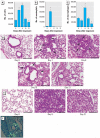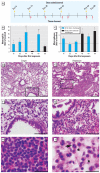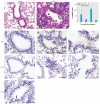Lung inflammation, injury, and proliferative response after repetitive particulate hexavalent chromium exposure
- PMID: 20049209
- PMCID: PMC2799464
- DOI: 10.1289/ehp.0900715
Lung inflammation, injury, and proliferative response after repetitive particulate hexavalent chromium exposure
Abstract
Background: Chronic inflammation is implicated in the development of several human cancers, including lung cancer. Certain particulate hexavalent chromium [Cr(VI)] compounds are well-documented human respiratory carcinogens that release genotoxic soluble chromate and are associated with fibrosis, fibrosarcomas, adenocarcinomas, and squamous cell carcinomas of the lung. Despite this, little is known about the pathologic injury and immune responses after repetitive exposure to particulate chromates.
Objectives: In this study we investigated the lung injury, inflammation, proliferation, and survival signaling responses after repetitive exposure to particulate chromate.
Methods: BALB/c mice were repetitively treated with particulate basic zinc chromate or saline using an intranasal exposure regimen. We assessed lungs for Cr(VI)-induced changes by bronchoalveolar lavage, histologic examination, and immunohistochemistry.
Results: Single exposure to Cr(VI) resulted in inflammation of lung tissue that persists for up to 21 days. Repetitive Cr(VI) exposure induced a neutrophilic inflammatory airway response 24 hr after each treatment. Neutrophils were subsequently replaced by increasing numbers of macrophages by 5 days after treatment. Repetitive Cr(VI) exposure induced chronic peribronchial inflammation with alveolar and interstitial pneumonitis dominated by lymphocytes and macrophages. Moreover, chronic toxic mucosal injury was observed and accompanied by increased airway pro-matrix metalloprotease-9. Injury and inflammation correlated with airways becoming immunoreactive for phosphorylation of the survival signaling protein Akt and the proliferation marker Ki-67. We observed a reactive proliferative response in epithelial cells lining airways of chromate-exposed animals.
Conclusions: These data illustrate that repetitive exposure to particulate chromate induces chronic injury and an inflammatory microenvironment that may promote Cr(VI) carcinogenesis.
Keywords: chromium; hexavalent; inflammation; injury; intranasal; lung; proliferation; repair.
Figures




Similar articles
-
Lung injury, inflammation and Akt signaling following inhalation of particulate hexavalent chromium.Toxicol Appl Pharmacol. 2009 Feb 15;235(1):47-56. doi: 10.1016/j.taap.2008.11.018. Epub 2008 Dec 9. Toxicol Appl Pharmacol. 2009. PMID: 19109987 Free PMC article.
-
Exposure to particulate hexavalent chromium exacerbates allergic asthma pathology.Toxicol Appl Pharmacol. 2012 Feb 15;259(1):38-44. doi: 10.1016/j.taap.2011.12.001. Epub 2011 Dec 9. Toxicol Appl Pharmacol. 2012. PMID: 22178736 Free PMC article.
-
The clastogenic effects of chronic exposure to particulate and soluble Cr(VI) in human lung cells.Mutat Res. 2006 Nov 7;610(1-2):8-13. doi: 10.1016/j.mrgentox.2006.06.006. Epub 2006 Jul 25. Mutat Res. 2006. PMID: 16870495
-
Assessment of the mode of action for hexavalent chromium-induced lung cancer following inhalation exposures.Toxicology. 2014 Nov 5;325:160-79. doi: 10.1016/j.tox.2014.08.009. Epub 2014 Aug 28. Toxicology. 2014. PMID: 25174529 Review.
-
Impact of hexavalent chromium on mammalian cell bioenergetics: phenotypic changes, molecular basis and potential relevance to chromate-induced lung cancer.Biometals. 2014 Jun;27(3):409-43. doi: 10.1007/s10534-014-9726-7. Epub 2014 Mar 25. Biometals. 2014. PMID: 24664226 Review.
Cited by
-
Inflammatory effects of hexavalent chromium in the lung: A comprehensive review.Toxicol Appl Pharmacol. 2022 Nov 15;455:116265. doi: 10.1016/j.taap.2022.116265. Epub 2022 Oct 5. Toxicol Appl Pharmacol. 2022. PMID: 36208701 Free PMC article. Review.
-
Protective effect of suppressing STAT3 activity in LPS-induced acute lung injury.Am J Physiol Lung Cell Mol Physiol. 2016 Nov 1;311(5):L868-L880. doi: 10.1152/ajplung.00281.2016. Epub 2016 Sep 16. Am J Physiol Lung Cell Mol Physiol. 2016. PMID: 27638904 Free PMC article.
-
Different roles of ROS and Nrf2 in Cr(VI)-induced inflammatory responses in normal and Cr(VI)-transformed cells.Toxicol Appl Pharmacol. 2016 Sep 15;307:81-90. doi: 10.1016/j.taap.2016.07.016. Epub 2016 Jul 26. Toxicol Appl Pharmacol. 2016. PMID: 27470422 Free PMC article.
-
Association between Concentrations of Metals in Urine and Adult Asthma: A Case-Control Study in Wuhan, China.PLoS One. 2016 May 18;11(5):e0155818. doi: 10.1371/journal.pone.0155818. eCollection 2016. PLoS One. 2016. PMID: 27191859 Free PMC article.
-
Comparative mouse lung injury by nickel nanoparticles with differential surface modification.J Nanobiotechnology. 2019 Jan 7;17(1):2. doi: 10.1186/s12951-018-0436-0. J Nanobiotechnology. 2019. PMID: 30616599 Free PMC article.
References
-
- Albini A, Sporn MB. The tumour microenvironment as a target for chemoprevention. Nat Rev Cancer. 2007;7:139–147. - PubMed
-
- Altomare DA, Testa JR. Perturbations of the AKT signaling pathway in human cancer. Oncogene. 2005;24:7455–7464. - PubMed
-
- American Cancer Society. Cancer Facts & Figures 2008. Atlanta, GA: American Cancer Society; 2008. [[accessed 29 October 2009]]. Available: http://www.cancer.org/docroot/stt/content/stt_1x_cancer_facts_and_figure....
-
- Antonini JM, Stone S, Roberts JR, Chen B, Schwegler-Berry D, Afshari AA, et al. Effect of short-term stainless steel welding fume inhalation exposure on lung inflammation, injury, and defense responses in rats. Toxicol Appl Pharmacol. 2007;223:234–245. - PubMed
-
- ATSDR. Toxicological Profile for Chromium. Atlanta, GA: Agency for Toxic Substances and Disease Registry; 2000. - PubMed
Publication types
MeSH terms
Substances
Grants and funding
LinkOut - more resources
Full Text Sources
Medical
Molecular Biology Databases

